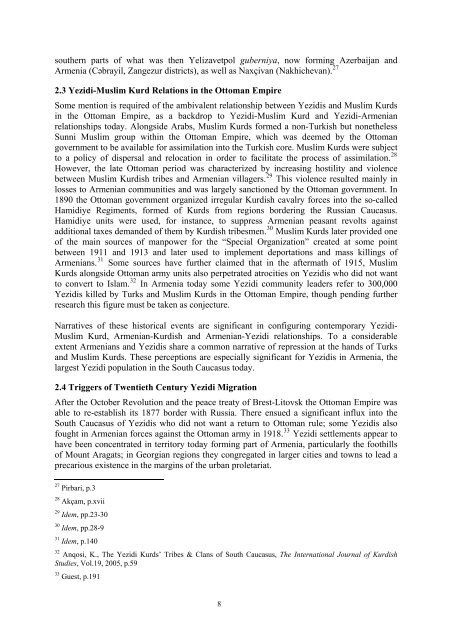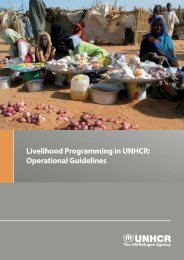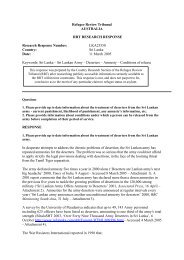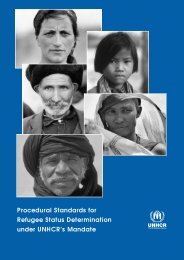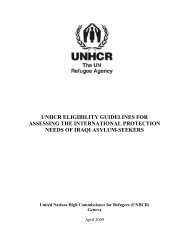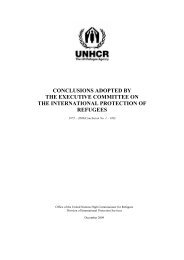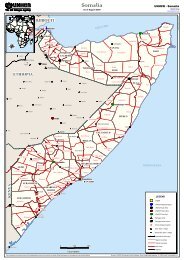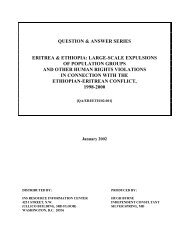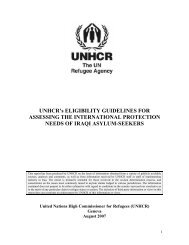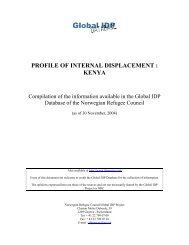The Human Rights situation of the Yezidi minority - UNHCR
The Human Rights situation of the Yezidi minority - UNHCR
The Human Rights situation of the Yezidi minority - UNHCR
You also want an ePaper? Increase the reach of your titles
YUMPU automatically turns print PDFs into web optimized ePapers that Google loves.
sou<strong>the</strong>rn parts <strong>of</strong> what was <strong>the</strong>n Yelizavetpol guberniya, now forming Azerbaijan and<br />
Armenia (Cəbrayil, Zangezur districts), as well as Naxçivan (Nakhichevan). 27<br />
2.3 <strong>Yezidi</strong>-Muslim Kurd Relations in <strong>the</strong> Ottoman Empire<br />
Some mention is required <strong>of</strong> <strong>the</strong> ambivalent relationship between <strong>Yezidi</strong>s and Muslim Kurds<br />
in <strong>the</strong> Ottoman Empire, as a backdrop to <strong>Yezidi</strong>-Muslim Kurd and <strong>Yezidi</strong>-Armenian<br />
relationships today. Alongside Arabs, Muslim Kurds formed a non-Turkish but none<strong>the</strong>less<br />
Sunni Muslim group within <strong>the</strong> Ottoman Empire, which was deemed by <strong>the</strong> Ottoman<br />
government to be available for assimilation into <strong>the</strong> Turkish core. Muslim Kurds were subject<br />
to a policy <strong>of</strong> dispersal and relocation in order to facilitate <strong>the</strong> process <strong>of</strong> assimilation. 28<br />
However, <strong>the</strong> late Ottoman period was characterized by increasing hostility and violence<br />
between Muslim Kurdish tribes and Armenian villagers. 29 This violence resulted mainly in<br />
losses to Armenian communities and was largely sanctioned by <strong>the</strong> Ottoman government. In<br />
1890 <strong>the</strong> Ottoman government organized irregular Kurdish cavalry forces into <strong>the</strong> so-called<br />
Hamidiye Regiments, formed <strong>of</strong> Kurds from regions bordering <strong>the</strong> Russian Caucasus.<br />
Hamidiye units were used, for instance, to suppress Armenian peasant revolts against<br />
additional taxes demanded <strong>of</strong> <strong>the</strong>m by Kurdish tribesmen. 30 Muslim Kurds later provided one<br />
<strong>of</strong> <strong>the</strong> main sources <strong>of</strong> manpower for <strong>the</strong> “Special Organization” created at some point<br />
between 1911 and 1913 and later used to implement deportations and mass killings <strong>of</strong><br />
Armenians. 31 Some sources have fur<strong>the</strong>r claimed that in <strong>the</strong> aftermath <strong>of</strong> 1915, Muslim<br />
Kurds alongside Ottoman army units also perpetrated atrocities on <strong>Yezidi</strong>s who did not want<br />
to convert to Islam. 32 In Armenia today some <strong>Yezidi</strong> community leaders refer to 300,000<br />
<strong>Yezidi</strong>s killed by Turks and Muslim Kurds in <strong>the</strong> Ottoman Empire, though pending fur<strong>the</strong>r<br />
research this figure must be taken as conjecture.<br />
Narratives <strong>of</strong> <strong>the</strong>se historical events are significant in configuring contemporary <strong>Yezidi</strong>-<br />
Muslim Kurd, Armenian-Kurdish and Armenian-<strong>Yezidi</strong> relationships. To a considerable<br />
extent Armenians and <strong>Yezidi</strong>s share a common narrative <strong>of</strong> repression at <strong>the</strong> hands <strong>of</strong> Turks<br />
and Muslim Kurds. <strong>The</strong>se perceptions are especially significant for <strong>Yezidi</strong>s in Armenia, <strong>the</strong><br />
largest <strong>Yezidi</strong> population in <strong>the</strong> South Caucasus today.<br />
2.4 Triggers <strong>of</strong> Twentieth Century <strong>Yezidi</strong> Migration<br />
After <strong>the</strong> October Revolution and <strong>the</strong> peace treaty <strong>of</strong> Brest-Litovsk <strong>the</strong> Ottoman Empire was<br />
able to re-establish its 1877 border with Russia. <strong>The</strong>re ensued a significant influx into <strong>the</strong><br />
South Caucasus <strong>of</strong> <strong>Yezidi</strong>s who did not want a return to Ottoman rule; some <strong>Yezidi</strong>s also<br />
fought in Armenian forces against <strong>the</strong> Ottoman army in 1918. 33 <strong>Yezidi</strong> settlements appear to<br />
have been concentrated in territory today forming part <strong>of</strong> Armenia, particularly <strong>the</strong> foothills<br />
<strong>of</strong> Mount Aragats; in Georgian regions <strong>the</strong>y congregated in larger cities and towns to lead a<br />
precarious existence in <strong>the</strong> margins <strong>of</strong> <strong>the</strong> urban proletariat.<br />
27 Pirbari, p.3<br />
28 Akçam, p.xvii<br />
29 Idem, pp.23-30<br />
30 Idem, pp.28-9<br />
31 Idem, p.140<br />
32<br />
Anqosi, K., <strong>The</strong> <strong>Yezidi</strong> Kurds’ Tribes & Clans <strong>of</strong> South Caucasus, <strong>The</strong> International Journal <strong>of</strong> Kurdish<br />
Studies, Vol.19, 2005, p.59<br />
33 Guest, p.191<br />
8


